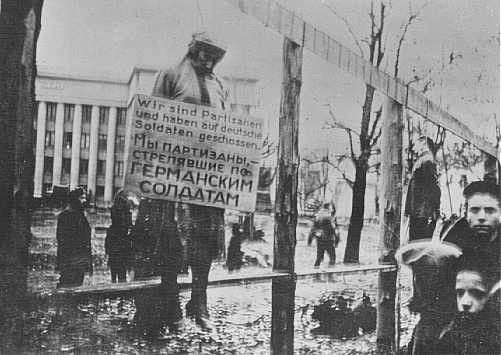Despite great risks and challenges, many Jews attempted armed resistance across German-occupied Europe. Jews engaged in resistance at both the individual and group levels. Among their efforts were uprisings in killing centers and ghettos.
![Jewish partisans in Naliboki forest, near Novogrudok. [LCID: 76525] Jewish partisans in Naliboki forest, near Novogrudok. [LCID: 76525]](https://encyclopedia.ushmm.org/images/large/e7ef107f-50c7-4445-88ef-365d9f2d7b63.jpg)
Partisans in the Naliboki forest, near Novogrudok. They were from various fighting units including the Bielski group and escapees from the Mir Ghetto on guard duty at an airstrip in the Naliboki Forest. Poland, July 1944.
Item View![Three participants in the Treblinka uprising who escaped and survived the war. [LCID: 66111] Three men walk together down the middle of a busy street. Each one is wearing a suit of a different color.](https://encyclopedia.ushmm.org/images/large/1c772279-a5ce-457d-aeb0-a50408560715.jpg)
Three participants in the Treblinka uprising who escaped and survived the war. Photograph taken in Warsaw, Poland, 1945.
Pictured from left to right are: Abraham Kolski, Lachman and Brenner. After participating in the Treblinka uprising, they escaped from the camp and found temporary refuge in the nearby forest. Afterwards they hid with a Christian family until liberation.
![A group portrait of some of the participants in the uprising at the Sobibor killing center. [LCID: 10625] A group portrait featuring two rows of six people each.](https://encyclopedia.ushmm.org/images/large/d2214370-1f6e-478e-a2ed-7d412e8ffa13.jpeg)
A group portrait including survivors of the Sobibor killing center and participants in the Sobibor uprising. Poland, August 1944.
Item View![A group of Jewish resisters, members of a fighting organization (Organisation Juive de Combat). [LCID: 31281] A group of Jewish resisters, members of a fighting organization (Organisation Juive de Combat). [LCID: 31281]](https://encyclopedia.ushmm.org/images/large/a7345c3a-deb9-4659-addd-7e3b2b878e87.jpeg)
A group of Jewish resisters, members of a fighting organization (Organisation Juive de Combat). Mazamet, France, wartime.
Item View![A group of Jewish partisans, members of a unit of the Armee Juive (Jewish Army). [LCID: 90355] A group of Jewish partisans, members of a unit of the Armee Juive (Jewish Army). [LCID: 90355]](https://encyclopedia.ushmm.org/images/large/9058fb8f-1425-4e8f-b000-739cf8bdf9ca.jpeg)
A group of Jewish partisans, members of a unit of the Armée Juive (Jewish Army). France, wartime.
Item View![Two partisans during the uprising before liberation. [LCID: 63700] Two partisans during the uprising before liberation. [LCID: 63700]](https://encyclopedia.ushmm.org/images/large/29d87a86-9b5b-4e87-b26e-a01b351da5b1.jpg)
Bedukian Sarkis, a French partisan of Armenian extraction, patrols a street along with another partisan during the August 1944 insurrection in the south of France. Marseille, France, August 1944.
Item View![Shortly before liberation by Allied forces, French resistance fighters staged uprisings across occupied France. [LCID: 63706a] Shortly before liberation by Allied forces, French resistance fighters staged uprisings across occupied France. [LCID: 63706a]](https://encyclopedia.ushmm.org/images/large/7fe8ddbb-329a-48c2-b317-7624e748f96d.jpg)
Shortly before liberation by Allied forces, French resistance fighters staged uprisings across occupied France. Here, fighters gather arms during the Marseille uprising. Marseille, France, August 1944.
Item View![Jewish partisans pose for a group photo in the Carpathian Mountains. [LCID: 86281] Jewish partisans pose for a group photo in the Carpathian Mountains. [LCID: 86281]](https://encyclopedia.ushmm.org/images/large/ce0251cb-8ffa-40d5-af7b-688ff41c8828.jpg)
Jewish partisans pose for a group photo in the Carpathian Mountains. Czechoslovakia, between 1943 and 1945.
Item View![Jewish partisans who operated in forests in Lithuania. 1944. [LCID: 70796] Jewish partisans who operated in forests in Lithuania. 1944. [LCID: 70796]](https://encyclopedia.ushmm.org/images/large/843109be-82f5-46ae-9ef6-e13bf4d661d9.jpg)
Group portrait of a Jewish partisan unit operating in the Lithuanian forests. Many of its members had been involved in resistance activities in the Kovno ghetto. Lithuania, 1944.
Item View![Jewish partisan Boris Yochai plants dynamite on a railroad track. [LCID: 76847a] Jewish partisan Boris Yochai plants dynamite on a railroad track. [LCID: 76847a]](https://encyclopedia.ushmm.org/images/large/40ee6783-cab7-461d-bfd0-a554a0f4bc5d.jpg)
Jewish partisan Boris Yochai plants dynamite on a railroad track. Vilna, 1943 or 1944.
Item View![Three Jewish partisans in Wyszkow Forest near Warsaw. [LCID: 85803] Three Jewish partisans in Wyszkow Forest near Warsaw. [LCID: 85803]](https://encyclopedia.ushmm.org/images/large/c2b7e771-d4c4-4e8d-9cfa-8d15dc9d8d97.jpg)
Three Jewish partisans in the Wyszkow Forest near Warsaw. Poland, between 1943–44.
Item View![A captured Jewish resistance fighter who was forced out of his hidden bunker by German soldiers during the Warsaw ghetto uprising. [LCID: 73896] A disheveled man stands on a city street in front of a uniformed soldier surrounded by rubble. The soldier has his hand on the man’s shoulder and appears to be leading him. There are two other uniformed soldiers on the right side of the photograph. Both hold firearms.](https://encyclopedia.ushmm.org/images/large/7ac2453d-33d1-47b6-9757-56c03a18f0d2.jpeg)
A captured Jewish resistance fighter who was forced out of his hidden bunker by German soldiers during the Warsaw ghetto uprising. Warsaw, Poland, April 19-May 16, 1943.
Item View![Jewish partisans in the Polesye region. Poland, 1943. [LCID: 12193] Jewish partisans in the Polesye region. Poland, 1943. [LCID: 12193]](https://encyclopedia.ushmm.org/images/large/4b7d62e2-d984-4f6e-9925-cf6c06943242.jpg)
Jewish partisans in the Polesye region. Poland, 1943.
Item View![A group of Jewish partisans in the Rudniki forest, near Vilna, between 1942 and 1944. [LCID: 04097] A group of Jewish partisans in the Rudniki forest, near Vilna, between 1942 and 1944. [LCID: 04097]](https://encyclopedia.ushmm.org/images/large/4f728076-da8b-4921-a9c2-26834c0b5d06.jpg)
A group of Jewish partisans in the Rudniki forest, near Vilna, between 1942 and 1944.
Item View![Portrait of Jewish partisans. Bedzin ghetto, Poland, between 1942 and 1943. [LCID: 46678] Portrait of Jewish partisans. Bedzin ghetto, Poland, between 1942 and 1943. [LCID: 46678]](https://encyclopedia.ushmm.org/images/large/f955e418-26ed-4ded-bc00-9f94a880b42f.jpg)
Portrait of Jewish partisans. Bedzin ghetto, Poland, between 1942 and 1943.
Item View
The public hanging of three members of the Communist underground on Karl Marx Street in Minsk. One of the victims wears a large placard around his neck that reads "We are partisans and have shot at German soldiers."
This execution was one of four carried out in Minsk on October 26, 1941, by German troops with the 707th Infantry Division. Altogether, 12 members of the Communist underground were publicly hanged in four groups of three near a yeast-making factory. This is believed to be the first public execution after the German invasion of the Soviet Union and it included the hanging of Masha Bruskina, a young Jewish woman. In each of the four cases, the bodies were left to hang for several days to serve as a warning to would-be resisters.
We would like to thank Crown Family Philanthropies, Abe and Ida Cooper Foundation, the Claims Conference, EVZ, and BMF for supporting the ongoing work to create content and resources for the Holocaust Encyclopedia. View the list of donor acknowledgement.